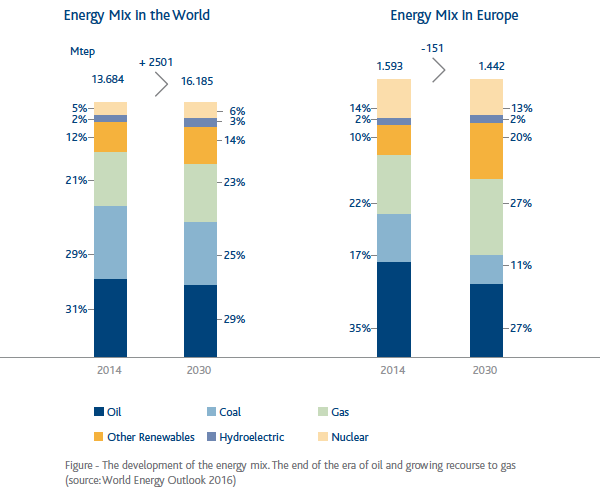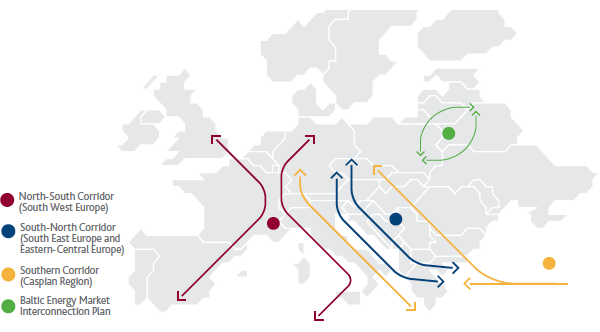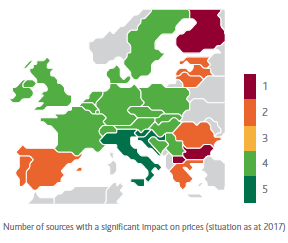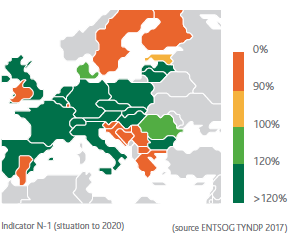Energy Union: an opportunity
Snam is supporting the construction of new infrastructures that exploit our country’s strategic position to diversify the procurement of gas and guarantee the security of supplies and greater system flexibility.
Gas is a vital energy source for Italy, on average satisfying 36% of requirements, and for Europe this figure is 23%.
The development of the energy scenario
The demand for energy will grow over the next fifteen years, thanks, above all, to the momentum from emerging countries, which will offset the anticipated fall in demand from countries with more developed economies.
The pillars of the global energy system continue to be fossil fuels, but their weighting in the mix will gradually be reduced (81% in 2014 compared with a projected figure of 76% for 2030). Demand for gas, on the other hand, will rise to 790 Mega Tonnes of Oil Equivalent in 2030.
This trend is even more marked at European level, where there has been a decisive fall in demand for oil and coal and a rise in demand for gas (approximately 50 MTOE) and renewable fuels, taking into consideration the development of the industrial footprint and, especially, the energy efficiency policies and reduction of carbon dioxide promoted by the European Union.
The development of the energy mix:
the end of the era of oil and growing recourse to gas

The security of gas supplies
Italy depends greatly on gas imports: over 90% of its needs is covered by supplies from Russia, Algeria, Libya and other countries.
If gas, like every energy resource, follows the route of demand, then Europe has a lot to do: accounting for 13% of global consumption it actually only possesses 1% of reserves, and has to make up the difference through imports. These figures give rise to the vital need to guarantee procurement security through long-term strategies and policies, promoting greater market liquidity and facilitating integration through the development of network connections.
In this situation opening up new routes and connecting Italy with strategic areas of the Eastern Mediterranean and Caspian Sea where the countries involved bring their gas to Europe becomes vital.
The increased development of the gas market in Italy and its full integration with European markets will, according to forecasts, have a positive impact on energy prices, cutting costs for Italian businesses and enabling important savings for households.
The domestic electrical system power plants would also benefit, with around 40% of production linked to gas, penalised by the subsidised development of renewable energy sources and maintaining the weighting of coal in the electricity generation mix.
In years to come it will also be vital to upgrade current transmission systems and develop new LNG storage plants and terminals, in efficient locations connected with the existing network to deal with changes in demand for energy and guarantee an adequate response to consumer needs.
Energy corridors and Italy’s key role
Thanks to the interconnectivity of the Snam network, Italy is already the country in Europe that can count on the largest number of sources of supply. As well as from domestic production, the Italian system can also receive gas through four imports via gas pipelines and 3 regasification terminals.
Italy is included in 3 of the 4 priority energy corridors under the projects of common interest defined by the European Commission.
In 2020, it is projected that gas will also be imported from the Caspian Sea region through the construction of the Trans Adriatic Pipeline, the terminal pipeline of the projects for the Southern Gas Corridor, one of the European Union’s strategic priorities.
The development of the two-way capacity in the north of Italy along the South-North corridor (reverse flow), which is expected to be completed in 2018, may make Italian sources of supply accessible to other European countries.

DIVERSIFICATION OF SOURCES OF SUPPLY

SECURITY OF SUPPLIES

Despite its high dependency on imports, Italy has the greatest degree of diversification in Europe of procurement routes and sources.
Indicator N-1 is a system infrastructure flexibility indicator: at the time when the largest source of procurement starts to fail it indicates how the country is capable of replacing it by using other available sources. As far as Italy is concerned, if one of the procurement sources fails, the remaining infrastructures are capable of satisfying over 120% of the area’s total demand for gas, calculated during a day when demand for gas is particularly high.